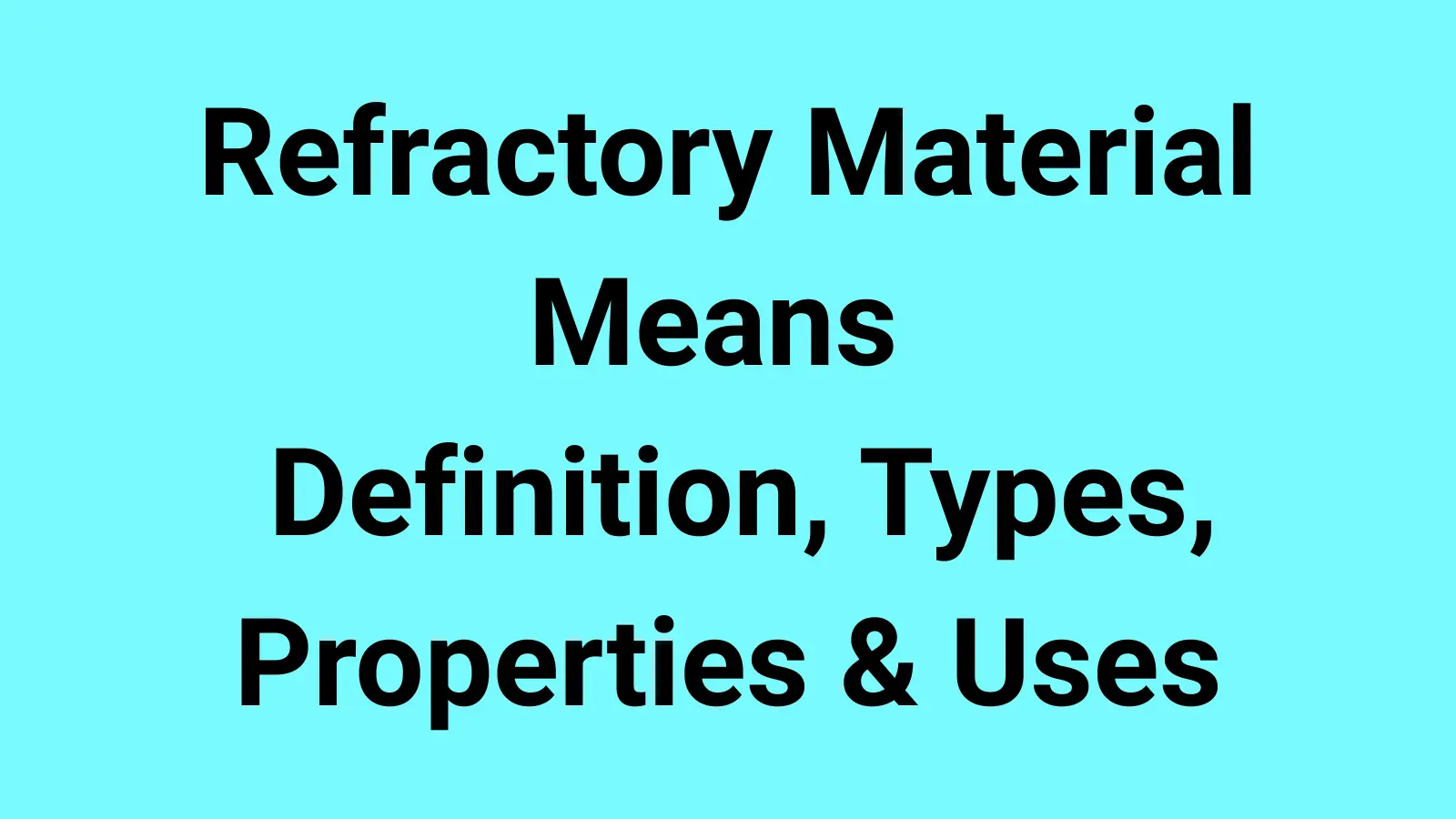When someone asks “Refractory material means what?” the simplest answer is: a material that can withstand extremely high temperatures without melting, breaking down, or reacting chemically.
In other words, refractory material means a heat-resistant substance commonly used in furnaces, kilns, incinerators, power plants, and industrial manufacturing units. These materials are designed to endure heat, pressure, corrosion, and wear where ordinary construction materials would fail.
From steel plants to rocket engines, refractory materials play a critical role in modern industries.
This article provides a complete guide to what refractory material means, including its definition, types, properties, manufacturing, applications, and real-world examples.
Whether you are a student, an engineer, or just curious, this guide will help you understand refractory materials in a simple, practical way.
📌 Refractory Material Means: Basic Definition
Understanding the foundation is key. Here’s what refractory material really means:
- 🔥 Heat resistance – Materials that can survive above 1,000°C (1,832°F).
- 🧱 Construction role – Used in furnaces, kilns, boilers, and chimneys.
- ⚡ Industrial backbone – Essential for steel, cement, glass, and ceramics industries.
- 🧪 Chemical stability – Doesn’t react with slag, hot gases, or molten metals.
- 🛡️ Durability – Designed to withstand mechanical stress at high temperatures.
- 🌋 Natural & synthetic – Includes clay, silica, magnesite, and engineered compounds.
- 🧭 Ancient use – Egyptians used early refractory bricks for pottery.
- 🔍 Modern definition – Any material resistant to thermal, chemical, and physical attack.
- 💡 Key property – Retains strength and shape in extreme heat.
- 🛠️ Forms – Bricks, castables, mortars, and ceramic fibers.
- 🚀 Advanced uses – Spacecraft and jet engines use refractory coatings.
- 🏭 Heavy industries – Refractories are the invisible backbone of factories.
- ⏳ Longevity – Extends the life of furnaces and kilns.
- 🌎 Global need – Every industrial nation relies on refractories.
📌 Refractory Material Means in Industrial Context
In industries, refractory material means more than just “heat resistance.” It’s about survival under extreme working conditions.
- 🏗️ Steel industry – 70% of refractories go into steel production.
- 🧱 Cement industry – Kilns require lining to prevent breakdown.
- 🍾 Glass industry – Furnaces use silica-based refractories.
- ⚙️ Non-ferrous metals – Used in aluminum, copper, and zinc plants.
- ♻️ Incineration – Medical and municipal waste plants use refractories.
- 🔋 Energy sector – Boilers and nuclear plants depend on them.
- 🏭 Petrochemical industry – Handles corrosive chemicals at high heat.
- 🧪 Laboratory furnaces – Specialized refractories for R&D.
- 🛡️ Defense – Used in missile nozzles and aerospace shields.
- 🌱 Environmental role – Prevents toxic leaks during incineration.
- 💵 Cost factor – Improper refractories = millions lost in repairs.
- 🧩 Custom designs – Tailored for specific furnace conditions.
- 🚚 Transport – Found in vehicle exhausts and jet turbines.
- 🔑 Industry secret – Without refractories, heavy industries collapse.
📌 Types of Refractory Material Means
Refractories are classified by composition, form, and properties.
- 🧱 Acidic refractories – Silica, alumina, zirconia (resist acidic slags).
- 🧱 Basic refractories – Magnesia, dolomite (resist basic slags).
- 🧱 Neutral refractories – Chromite, graphite, carbon (resist both).
- 🏗️ Shaped refractories – Preformed bricks, tiles, blocks.
- 🏗️ Unshaped refractories – Castables, ramming mixes, coatings.
- 🪶 Lightweight refractories – Insulating materials to reduce heat loss.
- 🧲 Dense refractories – Withstand mechanical load.
- 🧪 Special refractories – Carbides, nitrides, borides for advanced uses.
- 🔥 Fireclay refractories – Most widely used traditional type.
- 💡 Silicon carbide refractories – High strength, low thermal expansion.
- 🛡️ Carbon refractories – For non-oxidizing environments.
- 🚀 Ultra-high temp refractories – Aerospace-grade ceramics.
- 🌊 Hydraulic refractories – Set with water like cement.
- 🌍 Eco-friendly refractories – Designed for sustainable industries.
📌 Properties of Refractory Material Means
Key qualities that define refractory material:
- 🔥 High melting point (above 1,500°C).
- 🛡️ Mechanical strength at elevated temperatures.
- 🧪 Chemical inertness against slag and gases.
- ⏳ Long service life in furnaces.
- 🧱 Dimensional stability (doesn’t deform easily).
- 💨 Thermal shock resistance (withstands sudden cooling/heating).
- ⚡ Electrical conductivity (varies by type, e.g., graphite is conductive).
- 🚫 Low thermal expansion (minimizes cracks).
- 🪶 Lightweight insulation for energy savings.
- 💎 Hardness to resist abrasion.
- 🧩 Porosity control (affects heat transfer).
- 🧲 Refractoriness under load (withstands pressure in kilns).
- 🌡️ Slag resistance (prevents chemical wear).
- 🌍 Eco-compatibility for green industries.
📌 Manufacturing of Refractory Materials
How refractory materials are made:
- ⛏️ Raw materials – Fireclay, bauxite, magnesite, silica.
- ⚙️ Crushing & grinding – Powdered for uniformity.
- 🧪 Mixing – Blended with binders like water or tar.
- 🧱 Shaping – Molded into bricks, blocks, or castable mixes.
- 🔥 Drying – Removes moisture.
- 🌡️ Firing – Heated in kilns to harden.
- 🛠️ Quality testing – Checked for strength and resistance.
- 🧲 Special coatings – Added for extra protection.
- 🧑🏭 Modern automation – Robotics in production.
- 🌱 Eco-friendly methods – Using recycled materials.
- 📦 Packaging – Delivered as bricks, powders, or monolithics.
- 🚚 Distribution – Supplied globally to industries.
- 🏭 Customization – Each furnace design = unique refractory design.
- 🔑 Precision engineering – Vital for performance.
📌 Applications: Refractory Material Means in Real Life
Refractories are everywhere in modern industries.
- 🏗️ Steelmaking furnaces.
- 🧱 Cement rotary kilns.
- 🍾 Glass melting tanks.
- 🔋 Power plant boilers.
- ♻️ Incinerators for waste.
- ⚙️ Aluminum smelters.
- 🚀 Rocket nozzles.
- 🔥 Ceramic kilns.
- ⛏️ Foundries and forges.
- 🏭 Petrochemical crackers.
- 🛡️ Nuclear reactors.
- 🧪 Lab test furnaces.
- 🚚 Automobile exhaust systems.
- 🛠️ Domestic fireplaces.
📌 Refractory Material Means for Students (Simplified)
Breaking it down in simple words:
- 🔥 A material that doesn’t melt easily.
- 🧱 Used in furnaces and ovens.
- 📚 Strong at high heat.
- 🛡️ Doesn’t react with hot chemicals.
- 🏗️ Needed in industries like steel and cement.
- 🎓 Studied in material science.
- 🧪 Found in labs too.
- 🚀 Even rockets use them!
- 🛋 Similar to heat-proof bricks.
- 🧑🏫 Important for engineering exams.
- 🔑 Keyword = “heat resistance.”
- 📲 Easy way: think of “fireproof bricks.”
- 🏭 Without refractories, industries can’t run.
- ✅ Answer in exams: “Materials resistant to heat, pressure, and chemicals.”
📌 Refractory Material Means in Construction
Construction industries rely heavily on refractories.
- 🏗️ Chimneys & flues lined with refractories.
- 🧱 Bricks for fireplaces.
- 🛠️ Protective coatings.
- 🚒 Fireproofing high-rise buildings.
- 🧪 Insulating industrial ovens.
- 🏭 Factories use them in boilers.
- 🛋 Home stoves & heaters.
- 🧩 Tiles in kilns.
- 🧑🏭 Foundry floors lined with refractories.
- 🚧 Used in cement industries.
- 💡 Saves energy.
- 🔥 Ensures safety.
- ⏳ Extends furnace life.
- 🌱 Sustainable construction material.
📌 Refractory Material Means in Modern Technology
Beyond traditional uses, refractories power new tech.
- 🚀 Rocket engines.
- 🛡️ Spacecraft shields.
- ⚡ Nuclear plants.
- 🔋 Lithium battery manufacturing.
- 🏎️ F1 car brakes.
- 🧪 High-tech ceramics.
- 🔥 Plasma arc furnaces.
- 📡 Satellites.
- 🕹 Gaming GPUs cooling systems (experimental).
- ⚙️ Semiconductor industry.
- 🧑🔬 Nanotechnology coatings.
- 💡 Renewable energy plants.
- 🌍 Eco-friendly energy projects.
- 🧲 Future quantum computers may use advanced ceramics.
📌 FAQs: Refractory Material Means
Q1: What does refractory material mean in simple words?
👉 A material that resists very high heat without breaking.
Q2: Where are refractory materials used?
👉 Furnaces, kilns, incinerators, steel plants, and rockets.
Q3: Are all refractories bricks?
👉 No, they can be castables, fibers, or coatings too.
Q4: What’s the difference between fireproof and refractory?
👉 Fireproof = resists burning. Refractory = resists extreme heat + chemicals.
Q5: Who invented refractory materials?
👉 Ancient civilizations like Egyptians used early fireclay.
Q6: What is the strongest refractory?
👉 Zirconia and silicon carbide are among the best.
Q7: Can refractories melt?
👉 Only at very extreme temps above 1,800–2,000°C.
Q8: Why are they important?
👉 They keep industries running safely and efficiently.
Q9: Are they eco-friendly?
👉 Modern refractories are being designed to be sustainable.
Q10: Can I see refractory materials at home?
👉 Yes, in stoves, ovens, and fireplaces.
📌 Conclusion: What Refractory Material Means 🔑
In short, refractory material means a specially designed heat-resistant substance that can endure extreme temperatures, chemical reactions, and mechanical stress without losing its properties.
These materials are essential for everything from steel plants and cement kilns to rockets and space technology. Without them, modern industries would simply not function.
Refractory materials are not just “fireproof” – they are the unsung heroes of industrial progress.



